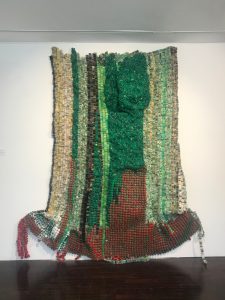In a time of ecological and economic crises, what significance does material culture hold? Can art play a role beyond aestheticism?
Material culture - the study of objects and the physical space they occupy, including works of art as objects - raises many questions in the art world, including the place artworks hold in defining a cultural history and identity. These questions are a constant topic of conversation among artists, viewers, and curators alike.
Having visited numerous UNESCO sites, historic landmarks, and almost every major city on my solo trip to Morocco in May, I was eager to see what the contemporary art scene was like and how it would compare to that of Montreal.
I had not read anything about the space prior to my visit to the Museum of African Contemporary Art Al Maaden (MACAAL), in Marrakech, Morocco. Nor had I done any research; I had no context as to what I would see or any expectations, for that matter.
The exhibition at the time of my visit, Material Insanity, featured the work of over 30 African artists, both from the continent and its diaspora, including Berlin-based conceptual artist Adrian Piper, and music collective KOKOKO!.
As the title suggests, Material Insanity explores the significance of material culture and commodification and creates a discourse surrounding collective cultural experiences revolving around materiality and visual imagery.
I’ve been thinking about this exhibition a lot since returning from my trip and as I visit many new art shows in and around Montreal. The exhibition and museum, as a whole, creates a space for engaging in a dialogue about the collective and individual experiences of artists throughout the continent, through references to culture, politics, and economics.
The MACAAL creates an environment where artists and viewers can converse about and reflect on issues that pertain to their cultural identity and experiences. I truly felt as though, for the first time, I was visiting a museum that held cultural significance and begged for answers to pertinent questions.

Having previously read and written about Moffat Takadiwa, a multi-disciplinary Zimbabwean artist, I was overwhelmed, to say the least, when I saw one of his works featured in the museum.
Takadiwa’s work explores personal and collective histories through the use of recycled and found objects. His visual interpretation of current issues makes a commentary on material culture in conjunction with the economic crisis of his country and community.
Takadiwa’s piece, Washen Again, is composed of toothbrushes and dishwashing soap bottle tops. The large scale sculpture shares similar qualities to an intricate rug; the found objects placed methodically to give the appearance of woven details, alternating in tones of red, green, and beige.
The featured works’ significance speaks to the importance of imagery and visual culture, while simultaneously playing a pertinent role in an ongoing ecological crisis. The act of repurposing found objects that no longer serve a purpose, and breathing new life into them, demonstrates the artistic capabilities of the exhibited artists.
The MACAAL’s creation and development of a dialogue - which at once explores relevant cultural issues and contributes to a continent’s cultural history and international representation - is a component that lacks from most large art institutions.
I cannot think of anything else that fully encompasses being an artist or curator, other than creating artwork with all that one has instead of buying new.
Further information about the Museum of African Contemporary Art Al Maaden can be found at www.macaal.org. A 3D tour of Material Insanity can be found at macaal.org/en/exhibitions/material-insanity/.
Photos by Lorenza Mezzapelle




